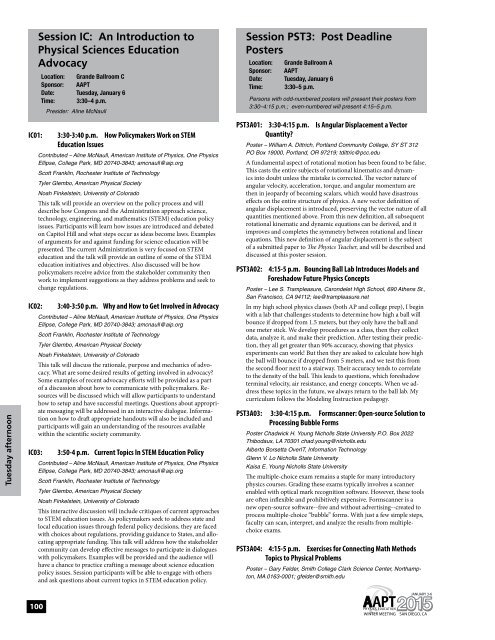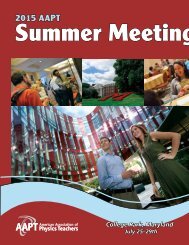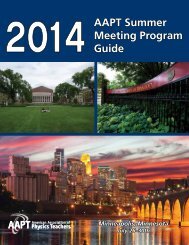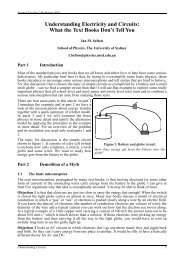final-program-12-23-14-3
final-program-12-23-14-3
final-program-12-23-14-3
Create successful ePaper yourself
Turn your PDF publications into a flip-book with our unique Google optimized e-Paper software.
Tuesday afternoon<br />
Session IC: An Introduction to<br />
Physical Sciences Education<br />
Advocacy<br />
100<br />
Location: Grande Ballroom C<br />
Sponsor: AAPT<br />
Date: Tuesday, January 6<br />
Time: 3:30–4 p.m.<br />
Presider: Aline McNaull<br />
IC01: 3:30-3:40 p.m. How Policymakers Work on STEM<br />
Education Issues<br />
Contributed – Aline McNaull, American Institute of Physics, One Physics<br />
Ellipse, College Park, MD 20740-3843; amcnaull@aip.org<br />
Scott Franklin, Rochester Institute of Technology<br />
Tyler Glembo, American Physical Society<br />
Noah Finkelstein, University of Colorado<br />
This talk will provide an overview on the policy process and will<br />
describe how Congress and the Administration approach science,<br />
technology, engineering, and mathematics (STEM) education policy<br />
issues. Participants will learn how issues are introduced and debated<br />
on Capitol Hill and what steps occur as ideas become laws. Examples<br />
of arguments for and against funding for science education will be<br />
presented. The current Administration is very focused on STEM<br />
education and the talk will provide an outline of some of the STEM<br />
education initiatives and objectives. Also discussed will be how<br />
policymakers receive advice from the stakeholder community then<br />
work to implement suggestions as they address problems and seek to<br />
change regulations.<br />
IC02:<br />
3:40-3:50 p.m. Why and How to Get Involved in Advocacy<br />
Contributed – Aline McNaull, American Institute of Physics, One Physics<br />
Ellipse, College Park, MD 20740-3843; amcnaull@aip.org<br />
Scott Franklin, Rochester Institute of Technology<br />
Tyler Glembo, American Physical Society<br />
Noah Finkelstein, University of Colorado<br />
This talk will discuss the rationale, purpose and mechanics of advocacy.<br />
What are some desired results of getting involved in advocacy<br />
Some examples of recent advocacy efforts will be provided as a part<br />
of a discussion about how to communicate with policymakers. Resources<br />
will be discussed which will allow participants to understand<br />
how to setup and have successful meetings. Questions about appropriate<br />
messaging will be addressed in an interactive dialogue. Information<br />
on how to draft appropriate handouts will also be included and<br />
participants will gain an understanding of the resources available<br />
within the scientific society community.<br />
IC03: 3:50-4 p.m. Current Topics In STEM Education Policy<br />
Contributed – Aline McNaull, American Institute of Physics, One Physics<br />
Ellipse, College Park, MD 20740-3843; amcnaull@aip.org<br />
Scott Franklin, Rochester Institute of Technology<br />
Tyler Glembo, American Physical Society<br />
Noah Finkelstein, University of Colorado<br />
This interactive discussion will include critiques of current approaches<br />
to STEM education issues. As policymakers seek to address state and<br />
local education issues through federal policy decisions, they are faced<br />
with choices about regulations, providing guidance to States, and allocating<br />
appropriate funding. This talk will address how the stakeholder<br />
community can develop effective messages to participate in dialogues<br />
with policymakers. Examples will be provided and the audience will<br />
have a chance to practice crafting a message about science education<br />
policy issues. Session participants will be able to engage with others<br />
and ask questions about current topics in STEM education policy.<br />
Session PST3: Post Deadline<br />
Posters<br />
Location: Grande Ballroom A<br />
Sponsor: AAPT<br />
Date: Tuesday, January 6<br />
Time: 3:30–5 p.m.<br />
Persons with odd-numbered posters will present their posters from<br />
3:30–4:15 p.m.; even-numbered will present 4:15–5 p.m.<br />
PST3A01: 3:30-4:15 p.m. Is Angular Displacement a Vector<br />
Quantity<br />
Poster – William A. Dittrich, Portland Community College, SY ST 3<strong>12</strong><br />
PO Box 19000, Portland, OR 97219; tdittric@pcc.edu<br />
A fundamental aspect of rotational motion has been found to be false.<br />
This casts the entire subjects of rotational kinematics and dynamics<br />
into doubt unless the mistake is corrected. The vector nature of<br />
angular velocity, acceleration, torque, and angular momentum are<br />
then in jeopardy of becoming scalars, which would have disastrous<br />
effects on the entire structure of physics. A new vector definition of<br />
angular displacement is introduced, preserving the vector nature of all<br />
quantities mentioned above. From this new definition, all subsequent<br />
rotational kinematic and dynamic equations can be derived, and it<br />
improves and completes the symmetry between rotational and linear<br />
equations. This new definition of angular displacement is the subject<br />
of a submitted paper to The Physics Teacher, and will be described and<br />
discussed at this poster session.<br />
PST3A02:<br />
4:15-5 p.m. Bouncing Ball Lab Introduces Models and<br />
Foreshadow Future Physics Concepts<br />
Poster – Lee S. Trampleasure, Carondelet High School, 690 Athens St.,<br />
San Francisco, CA 941<strong>12</strong>; lee@trampleasure.net<br />
In my high school physics classes (both AP and college prep), I begin<br />
with a lab that challenges students to determine how high a ball will<br />
bounce if dropped from 1.5 meters, but they only have the ball and<br />
one meter stick. We develop procedures as a class, then they collect<br />
data, analyze it, and make their prediction. After testing their prediction,<br />
they all get greater than 90% accuracy, showing that physics<br />
experiments can work! But then they are asked to calculate how high<br />
the ball will bounce if dropped from 5 meters, and we test this from<br />
the second floor next to a stairway. Their accuracy tends to correlate<br />
to the density of the ball. This leads to questions, which foreshadow<br />
terminal velocity, air resistance, and energy concepts. When we address<br />
these topics in the future, we always return to the ball lab. My<br />
curriculum follows the Modeling Instruction pedagogy.<br />
PST3A03: 3:30-4:15 p.m. Formscanner: Open-source Solution to<br />
Processing Bubble Forms<br />
Poster Chadwick H. Young Nicholls State University P.O. Box 2022<br />
Thibodaux, LA 70301 chad.young@nicholls.edu<br />
Alberto Borsetta OverIT, Information Technology<br />
Glenn V. Lo Nicholls State University<br />
Kaisa E. Young Nicholls State University<br />
The multiple-choice exam remains a staple for many introductory<br />
physics courses. Grading these exams typically involves a scanner<br />
enabled with optical mark recognition software. However, these tools<br />
are often inflexible and prohibitively expensive. Formscanner is a<br />
new open-source software--free and without advertising--created to<br />
process multiple-choice “bubble” forms. With just a few simple steps,<br />
faculty can scan, interpret, and analyze the results from multiplechoice<br />
exams.<br />
PST3A04: 4:15-5 p.m. Exercises for Connecting Math Methods<br />
Topics to Physical Problems<br />
Poster – Gary Felder, Smith College Clark Science Center, Northampton,<br />
MA 0163-0001; gfelder@smith.edu<br />
WINTER MEETING<br />
JANUARY 3-6<br />
2015<br />
SAN DIEGO, CA






